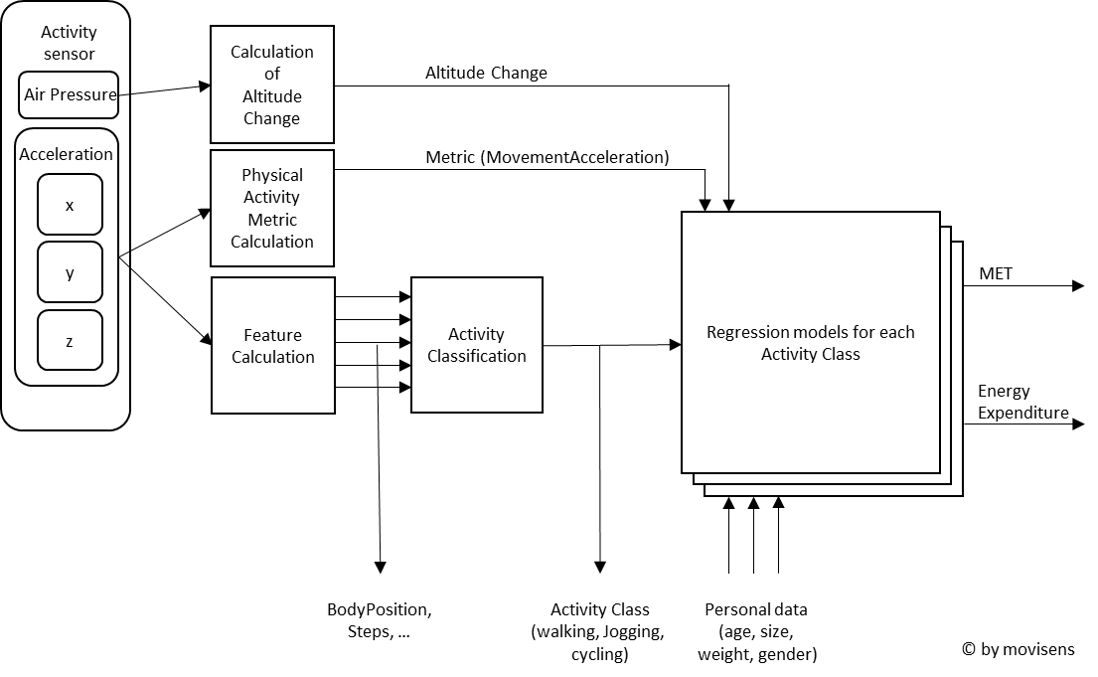# Energy expenditure
The calculation of both, energy expenditure and MET is done in two steps. In the first step an activity class is estimated based on acceleration and barometric signals. Depending on the detected activity class the corresponding model for energy expenditure/MET estimation is chosen. The model then takes the acceleration metric MovementAcceleration, the altitude change extracted from barometric data and the personal parameters age, gender, weight and height to calculate the energy expenditure/MET value. Energy expenditure/MET values are internally calculated for 1min intervals independent of the configured output interval.

This approach makes it possible to differentiate between activities with high activity intensity (and high acceleration) and low energy consumption (eg. going down stairs) and those with low activity intensity (and low acceleration) and high energy consumption (eg. cycling) and use appropriate models.
The models are built by regression from a large database of indirect calorie measurements for each physical activity class and sensor position. The quality of energy expenditure/MET estimation depends on sensor location. Best results can be achieved for the sensor positions hip and chest. Currently no models exist for thigh, ankle and upper arm. Energy Expenditure and MET can only reliably be calculated for people 12 years of age and above.
Literature and Validation:
- Härtel, Sascha, et al. "Estimation of energy expenditure using accelerometers and activity-based energy models - validation of a new device." European Review of Aging and Physical Activity 8.2 (2011): 109. (opens new window)
- Anastasopoulou P., Härtel S., Tubic M., Hey S.: Using Support Vector Regression for assessing Human Energy Expenditure using a Triaxial Accelerometer and a Barometer. Proceedings of the 3rd International Conference on Wireless Mobile Communication and Healthcare, Paris, France, 2012. (opens new window)
- Anastasopoulou P., Tubic M., Schmidt S., Neumann R., Woll A., Härtel S.: Validation and comparison of two methods to assess human energy expenditure during free-living activities. PLos ONE, 2014. (opens new window)
- Anastasopoulou P., Stetter B., Hey S.: Validierung der Bewegungsklassifikation des move II Aktivitätssensors im Alltag. Proceedings of the 21. Sportwissenschaftlicher Hochschultag der Deutschen Vereinigung für Sportwissenschaft, Konstanz, Germany, 2013. (opens new window)
- Armbruster, M., Anastasopoulou, P., Altmann, S., Ringhof, S., Neumann, R., Haertel, S. & Woll, A. (accepted). Energy Expenditure During Incline Walking – Benefits of Integrating a Barometer into Activity Monitors. American Journal of Sports Science. (opens new window)
# Metabolic Equivalent of Task (MET)
MET is a measure of energy expenditure. It is defined as the ratio of metabolic rate during a specific physical task to a reference metabolic rate. There a several definitions of 1 MET:
- 3.5 ml O2 / (kg min) for men, 3.15 ml /(kg min) for women
- 4,184 kJ / (kg h) = 1 kcal / (kg h)
Both definitions equate to about the resting metabolic rate. See chapter Energy expenditure for a detailed description of how the MET values are calculated. The output parameter MET has no unit [].
movisensLIVE: MET can be calculated live on the sensor.
# Activity energy expenditure (ActivityEnergyExpenditure)
Activity energy expenditure (AEE), is the energy expenditure caused by physical activity. See chapter Energy expenditure for a detailed description of how the MET values are calculated. The output parameter AEE has the unit [kcal/day].
# Total energy expenditure (TotalEnergyExpenditure)
Total energy expenditure is the estimated total expenditure of a person. It is put together by the basal metabolic rate (BMR) and the activity energy expenditure (AEE). BMR is estimated by the WHO equations from age, gender, weight and height. The output parameter TEE has the unit [kcal/day].
Literature:
- FAO/WHO/UNU. "Energy and protein requirements. Technical report series, no. 724." (1985), Annex 1: Equations for the Prediction of Basal Metabolic rate (opens new window)
- Henry, C. J. K. "Basal metabolic rate studies in humans: measurement and development of new equations." Public health nutrition 8.7a (2005): 1133-1152 (opens new window)
# PDF and Excel Reports
Several reports are available for the documentation of physical activity and energy expenditure. PDF reports can be used as incentives for participants. The report ReportActivityEeSummaryExcel gives a high-level summary of the physical activity.
| Report | Type | Description | Aligned at full days |
|---|---|---|---|
| ReportActivityEePdf | Detail report with plots of activity class, body position, steps, movement intensity, energy expenditure and MET level for each day (three pages per day). | no | |
| ReportActivityEeMediumPdf | Weekly plots for steps/day. Detailed plots of steps, activity class and energy expenditure for each day (one page per day). | no | |
| ReportActivityEeSummaryExcel | Excel | One line per day for energy expenditure, Activity Level, steps and activity classes | yes |